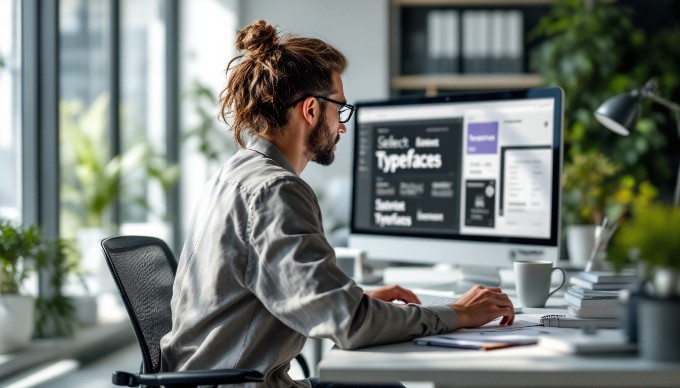Understanding typography for graphic design
What is typography for graphic design
Typography for graphic design is more than just picking out fonts—it’s the art and technique of arranging type to make written language legible, readable, and visually appealing. In graphic design, typography is a cornerstone that shapes the overall aesthetic and effectiveness of a design. It plays a crucial role in communicating the intended message and evoking the desired emotional response from the audience. With various types of typography, including serif, sans-serif, script, and decorative styles, designers can craft unique visual identities and enhance user experience. Understanding the significance of typography not only elevates the quality of your work but also ensures that your creations resonate with your audience. Dive into this exploration of typography in graphic design to discover how different typographic choices can transform your projects and captivate your viewers.

The role of typography in branding
Typography is a crucial element in graphic design that significantly influences branding. It goes beyond mere aesthetics; it plays a vital role in creating a strong brand identity and influencing how an audience perceives a brand. Understanding the impact of typography can help businesses effectively communicate their values and personality.
Creating brand identity
Typography helps establish a brand identity by conveying the brand’s tone and message. The choice of fonts, sizes, and styles can differentiate a brand from its competitors. For instance, a luxury brand might use elegant serif fonts to convey sophistication, while a tech company might opt for modern sans-serif fonts to reflect innovation and simplicity.
Influencing audience perception
The right typography choices can directly influence how an audience perceives a brand. Consider these aspects:
- Readability ensures that the message is easily understood, which is crucial for maintaining audience engagement.
- Emotional impact varies with different typefaces. A playful font can make a brand seem friendly, while a bold font might suggest strength and reliability.
- Consistency in typography across all branding materials reinforces brand recognition and trust.
Examples of effective typography in branding
Several brands have successfully leveraged typography to strengthen their branding:
- Coca-Cola’s iconic script font is instantly recognizable and evokes a sense of nostalgia and tradition.
- Google’s clean and modern sans-serif font reflects the brand’s focus on simplicity and accessibility.
- Disney’s whimsical and unique typeface captures the magical essence of the brand, appealing to both children and adults.
Incorporating effective typography in graphic design not only enhances visual appeal but also solidifies brand identity and shapes audience perception.
Expert graphic design services to elevate your brand. Book a call
Choosing the right typefaces
Selecting the appropriate typefaces is a crucial step in mastering typography for graphic design. The right choice can significantly enhance the visual appeal and effectiveness of your design. Here are some key considerations to help you choose the best typefaces for your projects.
Different types of typefaces play distinct roles in graphic design. Some of the most common categories include:
- Serif typefaces offer a traditional look with small lines or strokes attached to the end of a larger stroke in a letter or symbol. They are often used in print media due to their readability.
- Sans-serif typefaces lack the small projecting features found in serif fonts, offering a modern and clean appearance. They are widely used for digital content.
- Script typefaces mimic cursive handwriting, adding an elegant touch to designs but should be used sparingly to maintain readability.
- Display fonts are decorative and designed for short text in headlines or advertisements. They are eye-catching but can be challenging to read in large blocks of text.
When selecting typefaces for a project, consider the following tips:
- Purpose and audience are key. Understand the purpose of your design and the audience you are targeting. Different demographics may respond better to certain styles.
- Consistency ensures the typefaces complement each other and maintain a consistent look throughout the design.
- Hierarchy uses different typefaces to establish a visual hierarchy, guiding the viewer’s eye through the content effectively.
Readability and legibility are paramount in typography for graphic design. Poorly chosen typefaces can make content difficult to read and detract from the message. To ensure your typefaces are readable and legible:
- Choose typefaces with clear letterforms and spacing.
- Avoid overly decorative fonts for body text.
- Test your design on various devices and screen sizes to ensure readability across platforms.
By carefully selecting typefaces that align with the project’s goals and audience, and by prioritizing readability and legibility, you can create compelling and effective graphic designs.
The impact of hierarchy in typography
In the realm of typography for graphic design, understanding visual hierarchy is crucial for creating effective and engaging designs. Visual hierarchy guides the viewer’s eye, ensuring that the most important elements of your design are noticed first. This concept is essential for conveying the right message and ensuring clarity in your design work.
One of the primary ways to establish visual hierarchy is by using size and weight effectively. Larger and bolder text naturally draws attention, making it ideal for headlines or key points. Conversely, smaller and lighter text can be used for secondary information. By varying these elements, you can create a clear structure that guides the viewer through your content seamlessly.
Creating focal points with typography is another vital aspect of establishing hierarchy. Focal points act as anchors within your design, capturing the viewer’s attention and directing it towards essential information. Here are some tips to create effective focal points:
- Choose contrasting fonts to highlight important text against the rest of the design
- Incorporate color strategically to make certain words or phrases stand out
- Use whitespace effectively to isolate key text, making it more prominent
By understanding and implementing these principles of visual hierarchy, designers can enhance the readability and impact of their work. When done correctly, typography not only conveys information but also enriches the overall aesthetic of graphic design projects.
Best practices for typography in graphic design
Typography for graphic design plays a crucial role in creating visually appealing and effective designs. To master this art, consider the following best practices:
Maintaining consistency is key in typography for graphic design. Consistency helps in establishing a cohesive look throughout your project. This means sticking to a limited number of fonts and sizes to ensure your design does not look cluttered. It’s essential to use the same typefaces across different elements such as headings, subheadings, and body text. This enhances readability and helps convey a unified message.
Using contrast and color effectively can greatly enhance your typography in graphic design. Contrast can be achieved by mixing different font weights or sizes to highlight important information. Additionally, using contrasting colors between text and background can make your content stand out. Remember to:
- Choose colors that complement each other
- Ensure text is legible against the background
- Use bold or italic styles sparingly for emphasis
Balancing text and visuals is another important aspect of typography in graphic design. A well-balanced design ensures that neither the text nor the visuals overpower each other. Here’s how to achieve this balance:
- Allocate adequate space for text and images
- Use whitespace to separate elements and improve readability
- Align text and visuals in a way that guides the viewer’s eye naturally
By focusing on these best practices, you can create typography that not only enhances your graphic design but also communicates your message effectively.

Conclusion on typography for graphic design
In conclusion, the significance of typography for graphic design cannot be overstated. As we explored, typography is not just about selecting fonts; it is a powerful tool that enhances readability, conveys emotion, and strengthens brand identity. By understanding the principles of typography, such as hierarchy, alignment, and contrast, graphic designers can create visually compelling and communicative designs that resonate with their audience. We also emphasized the importance of experimenting with different typographic styles and techniques to discover what best complements your design objectives.
As you continue your journey in graphic design, remember that mastering typography is essential to elevating your work. This invites you to delve deeper into the nuances of typography for graphic design, experimenting with new fonts and layouts to find your unique style. By doing so, you’ll not only improve your design skills but also set your work apart in a competitive field. Keep exploring, learning, and applying these insights to create impactful and memorable designs.
Boost Engagement with Conversion-Driven Design
Enhance usability with optimized designs that convert users into customers.
Learn More